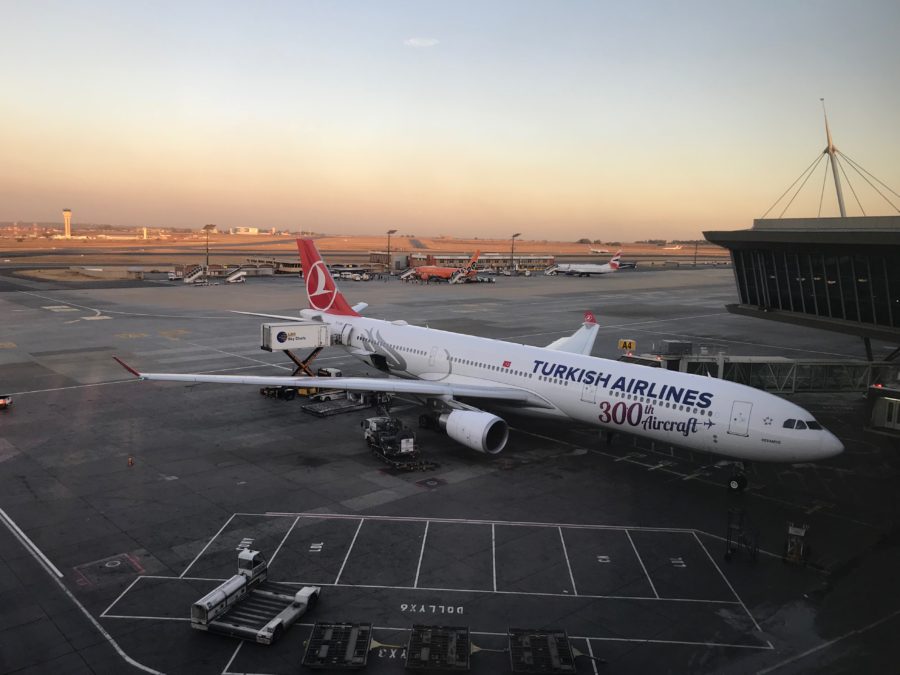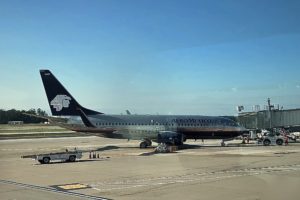Airline Profile: Turkish Airlines
The Facts:
| Alliance | Star Alliance |
| Competitors | AtlasGlobal Onur Air Pegasus Airlines |
| Fleet Count | Around 284 |
| Founded | 1933 |
| Frequent Flyer Program | Miles&Smiles |
| Headquarters | Istanbul, Turkey |
| Hubs | Istanbul New Airport (Main Hub) Istanbul Sabiha Gökçen International Airport Ankara Esenboğa International Airport |
| Parent Company | Turkish Airlines Group |
| Skytrax Rating | N/A |
| Subsidiaries | Anadolujet Air Albania SunExpress Turkish Cargo |
| Travel Classes | Economy Class Business Class |
| Type of Airline | Full Service |
| Website | turkishairlines.com |

Analysis:
Travel Classes:
Economy Class:
On Turkish Airlines, economy class is in a 3-3 configuration on all Airbus A320 series aircraft and on all Boeing 737s, a 2-4-2 configuration on all Airbus A330s and Airbus A340s, and is in a 3-3-3 configuration on Boeing 777s. Economy class features personal on-demand entertainment on select Airbus A321s and Boeing 737-800s, and on all Boeing 737-900s, Airbus A330s, Airbus A340s, and Boeing 777s. WiFi is only available on Boeing 777s and Airbus A330-300s.
Passengers receive amenity kits that have sleep masks, earplugs, socks, and more – a feature that is not available on many airlines. Passengers receive warm meals on all long-haul flights and most short haul flights, in contrast to most other European airlines which don’t serve meals in economy class on short flights. Economy class passengers are allowed to check one 20 kg (44 lbs) bag for each flight without charge. Also, passengers can also take one 50x40x23 cm and 8kg (17.5 lbs) bag on board as a carry on item.
Business Class:
Business class is featured on all aircraft (besides the Boeing 737-700) and features many different types of seats, which I explain below. The best part about business class on Turkish Airlines is probably the soft product, not the hard product. On longer international flights, there are always “Flying Chefs” traveling on board. They prepare personalized dishes on board to create probably one of the best culinary experiences for business class in the sky. Passengers in business class also receive amenity kits with amenities such as eyeshades, socks, toothbrushes, etc. People traveling in business class even get priority check-in, extra baggage allowance (30kg/66lbs), and earn more miles while flying.
Also, passengers get access to Turkish Airlines Lounges, including one of the most awarded business class lounges in the world – Lounge Istanbul. The lounge features recliner chairs, internet, full meals, sleeping rooms with actual beds, massage areas, and shower rooms. It also features amenities that aren’t featured at really any other lounges in the world, including a video games area, two grand pianos, a movie theater, a pool table, and children’s play areas.
Turkish Airlines features many different types of seats on board aircraft, none of them being that great. Fortunately, on the 787s and A350s that will be delivered starting in 2019, Turkish Airlines will feature a new business class seat which will have all aisle access and will have a large amount of privacy: hopefully it will have suites that have doors that can close fully like on Qatar Airways‘ Qsuites or Delta’s new A350 aircraft. Turkish Airlines shines in the soft product, but really (for now) is lacking on the hard product in business class. But for now, Turkish Airlines only features mediocre business class seats on most planes, which I will list below from worst to best.
Business Class Seats:
European Business Class:
On many short-haul aircraft, Turkish Airlines does have the standard European business class seat which features the same seat as in economy, but with the middle seat blocked. If possible, avoid aircraft with these business class seats at all cost, as this isn’t what you pay for in business class. These seats are featured on all Airbus A319s, and on some Airbus A320s and Boeing 737-800s.
Recliner Seats:
On all Airbus A321s and Boeing 737-900s, on most Airbus A320s and Boeing 737-800s, and on some Airbus A330-200s, Turkish Airlines features recliner seats which have leg rests and wider seats. For European standards, having recliner seats on 3-4 hour flights is far superior to having just economy class seats with the middle seat blocked, so they are above standard on those flights. However, aircraft such as the A330 and 737-900 which feature this seat also do fly on longer flights (6-7 hours), in which a flatbed seat in business class is ideal.
Angle-Flat Seats:
On most Airbus A330-200s and all Airbus A340-300s, business class features angle flat seats in a 2-2-2 configuration. These aircraft are flown on longer routes, so to have angle flat seats on 8-9 hour flights is unacceptable for a full-service carrier such as Turkish Airlines. Overall, while some Airbus A330-200s feature a good business class seat, most of them don’t, so the aircraft is generally worth avoiding in favor of aircraft such as the 777 which have flat bed seats.
Flat Bed Seats:
On all Boeing 777-300s, Airbus A330-300s, and on (I think) some Airbus A330-200s, business class features flat-bed seats in a 2-2-2 configuration (A330) or a 2-3-2 configuration (777). On ultra-long haul flights such as from Istanbul to Los Angeles, not having all aisle access is unacceptable on any airline. While they are better than recliner or angle-flat seats, really, they can’t compete with world-class seats such as the Qatar Airways QSuites.

Herringbone Seats:
On very few (less than 5) Airbus A330-200s which formerly flew for Jet Airways, Turkish Airlines features flat-bed seats in a 1-1-1 herringbone configuration. This means that the seats are angled from the window/middle of aircraft into the aisle. While these aren’t also world class, since this is the only seat with all aisle access on Turkish Airlines, I do rank it as the best seat on the airline.
Stelia Opal
Turkish Airlines recently introduced a new business class seat on their Boeing 787-9s. These seats represent their first seat with all aisle access (besides a couple ex Jet Airways A330s) and feature staggered seats in a 1-2-1 configuration. These seats represent a massive upgrade over their previous standard business class seats, which don’t feature all aisle access. These seats give passengers a lot of privacy and also are fully flat, making these seats by far Turkish Airlines’ best business class seats. Turkish Airlines currently flies their 787s to Denpasar, although they will also fly them to Washington Dulles, Atlanta, and Mexico City within the next couple of months.


Istanbul New Airport:
Istanbul Ataturk Airport reached its capacity and was pretty run down, so Istanbul came out with a new airport. Currently, Ataturk Airport is shut down for commercial operations, and all commercial flights have moved to Istanbul New Airport. Previously, for months, they ran a “trial run,” where Ataturk remain open for the majority of Turkish Airlines’ flights. This meant that some Turkish Airlines flights would operate from Istanbul New Airport, and some would operate out of Ataturk, which meant that some connections were tricky.
In mid spring of 2019, all flights moved to Istanbul New Airport. Please note that there have been multiple complaints of the workers building the airport because of awful working conditions, including 27 deaths of workers building the airport. I do hope that the situation of workers going on strike will get sorted and that the workers suffering lousy working conditions will be accommodated. There also have been a couple of other flaws with the airport, including many flights having to divert back to Ataturk due to heavy fog in the vicinity of Istanbul New Airport.

Have you ever flown on Turkish Airlines? Share about your experience below in the comments section!




